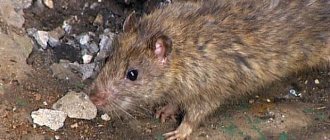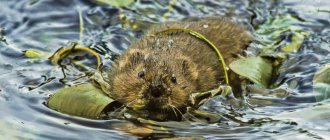The water rat is a very unpleasant animal. Unlike an ordinary rat, nature has awarded the water rat with an excellent fur coat and the ability to swim. Therefore, such rats settle along the banks of reservoirs and streams, but do not at all disdain to go inland, closer to vegetable gardens and garden plots. If you find torn out, broken plants with torn stems in your summer cottage, if the potato or carrot crop is close to destruction, and if you find earthen holes and passages throughout the entire plot - know that water rats live next to you! A water rat in the garden is a disaster, so without wasting time, start fighting these rodents.
Habitat elimination
The rodent emerges from the water in places overgrown with small bushes, littered with old trees, branches or garbage - all this perfectly covers the entrances and exits from rat houses. Tossed in a pile, old polyethylene from a greenhouse or greenhouse makes a great cover.
Although the water rat belongs to the vole family, it will not leave its hole and dig its network of underground passages “out of the blue.” Therefore, the first thing you need to do is put the area in order.
The shoreline of a pond or stream must be kept clean. Take out the garbage in a timely manner, do not leave piles of rotten grass, and do not stack tree branches after regular pruning. Create conditions under which the animal cannot feel safe, and it will be forced to look for another habitat.
Basic methods of struggle
To choose the most effective methods of pest control, you will need to understand each individual option. It is important not to delay the process in order to preserve vegetables and other vegetation in the garden as much as possible.
Rat poison poisoning
Reading reviews from summer residents, you can understand that using poison is the most effective method for eliminating pests. The effect of the poison is massive and effective, but simply scattering the poison will not be enough. Water rats are smart, they immediately understand that they are trying to be destroyed. To obtain the expected results, the poison is disguised in bait using bread crumbs and other food. The finished product should be placed near holes or beds. If desired, you can buy special baits that are more effective than bread or vegetables.
Rat poison for mice and rats: how it works and which is the most effective, read in this article.
Important! The main disadvantage of using poisons is that a rat can die anywhere on the site, so there is a risk of soil contamination with cadaveric poison. As soon as a water rat appears in the garden, you need to deal with it immediately. It is recommended to use one of three poisons.
Difa-Neo
A special grain bait that needs to be placed in holes and rat passages. It is often made from wheat soaked in chemicals. Manufacturers often use ethylphenacine for this.
Difa
Sold in the form of a paraffin briquette, which is perfect for places with high humidity.
Ratron Giftweizen
A fast-acting drug made in the form of granules. It is recommended to buy and use to get rid of pests very quickly.
Traps or snares
You can get rid of water rats in your area using traps and traps. They help quickly remove pests from the area, but the results will be positive with a small population.
Attention! After pests get into a trap or trap, it is necessary to quickly remove the corpse from the area. If this is not possible, then it is better to choose another liquidation option.
Mechanical
The method of disposal using mechanical traps is effective. Options include:
- traps;
- mousetraps;
- traps made according to various designs.
Arc traps are currently commercially available. They are buried about 20 cm into the soil, near the holes, and covered with earth. You can choose cylindrical models with a classic mechanism. This option can be done at the dacha with your own hands.
Adhesive
A good option for catching rats, but there is a drawback - the summer resident needs to constantly monitor the traps, check, and if the pest is caught, remove it. For the fight, such a measure turns out to be ineffective. Rats can get out of the sticky mass without much difficulty due to their size, which is larger than that of mice.
Electrical
Modern developments are also used in the production of pest traps. For these purposes, an electric valve is used, which can kill the animal with a discharge of current upon contact with the body of the pest. The method is effective, death occurs instantly, after discovering a corpse, you need to quickly remove it from the site.
Ultrasonic repellers
This option is humane, since under the influence of ultrasound the rats experience discomfort and begin to leave the area. The main disadvantage is that the process can be lengthy, because pests get used to the sounds. Well-thought-out repellers, whose sound range can be changed, help speed up the process.
If the dacha has a small cellar, barn or other room with an area of up to 200 sq. m., then you can use the “ElectroCat Classic” repeller. Its cost is about 1000 rubles. For areas up to 400 sq. m. it is recommended to choose “ElectroCat Turbo”, at a price of about 1300 rubles. These products will repel rats not only with sound, but also with light.
When choosing any type of repeller, you must strictly follow the manufacturer's instructions. At the same time, if possible, vacate the room as much as possible so that the ultrasound is better dissipated and repels.
Natural enemies
As soon as water rats appear in the garden, natural enemies come to the aid of the owners. The best cats are those that are able to eliminate animals very quickly. They love to hunt and in a few days they can destroy half of the entire livestock, the rest will go away on their own and will not return. However, not every cat is able to pick up the scent and kill a rat.
If the cat does not leave the apartment while spending time at the dacha, then you can use the contents of its tray. This option will be effective when filling the tray with wood filler on which the cat has urinated. It is recommended to bury the product shallowly in the ground. This will scare the rats, because they will think that a predator has appeared in the garden.
Dogs, especially hunting breeds, are more effective than some cats. However, there is no need to deliberately get such an animal; it is better to ask a neighbor to house his pet for a certain time.
Traditional methods
Rats are very sensitive to aromas, so improvised (folk) remedies have a positive effect if you want to get rid of them (The best ways to get rid of rats using folk remedies). Using simple methods, it is possible to influence the respiratory tract of rodents. So, there are both humane and aggressive means in which animals will suffocate or leave the area.
Black elderberry
The root system of black elderberry can be used to produce a rat poison called cyanide. The disadvantage of exterminating rats is that the process takes a long time, because the animals will not immediately leave their habitat. The shrub itself grows wild, but it can be planted on the site. In addition, cottage owners can use sheets that need to be placed in a hole to repel rodents with their aroma.
Spruce spruce branches
Spruce species of bushes and trees are no less useful. In this case, the repeller is not the aroma, but the prickly needles, which can cause damage to tissues and paws. To preserve vegetables and other plants, it is recommended to cover the soil with spruce branches or throw sharp objects directly into the holes. Spruce branches can be used for fruit bushes and trees; they are used to cover plants for the winter to preserve the bark.
Wood ash
In some cases, it will be enough to use wood ash. It contains alkali, which has a negative effect on bare paws and mucous membranes. In combination with spruce branches, the result will not be long in coming. In addition, the ash can be diluted with water and filled in the holes that appear. Dacha owners can scatter it near the passages to poison animals with alkali. If it gets into the stomach, the mucous membrane and organs of rodents will be corroded, followed by death.
Juniper branches
Juniper will help fight pests just as well as spruce branches. The plant has a pungent aroma and prickly needles. In this case, the smell will repel, and the branches will damage the paws. Rodents will want to quickly leave their habitat.
Singed wool
As an additional procedure, singed animal hair should be used, which is placed in a hole for smoking. Rodents cannot tolerate such a smell and can suffocate from it. You can use a rat corpse, set it on fire and throw it into an underground passage. As a result of this, the entire livestock leaves the temporary home. If there is no carcass, rabbit fur trimmings and pieces of natural fur will do.
Poisons
When fighting a water rat on a site, you will need poison with “lethal” force. For this purpose, chemicals based on compounds of zinc and phosphorus or arsenic are used. As a rule, these are rodenticide powders - pesticides against rodents. You can put them in bait.
For example, cut a potato, take out some of the inner center and place the poison in the recesses. Then secure both halves with toothpicks and leave them near rat holes and passages.
In the garden plot, it is useful to dig small ditches, place wooden boxes or small boxes in them, and cover them with earth or grass. First make an “entrance” into them and generously sprinkle the entire inner surface with toxic powder. Place some vegetable inside as bait.
You can do it easier - pour bleach - bleach - into the boxes. Bleach is a very strong oxidizing agent, which is why it is so popular in disinfection. Once it gets on the mucous membranes of a water rat - eyes, paw pads, abdominal skin - it will begin to corrode them. The animal will soon die. Be sure to use gloves and a respirator when working with poisons!
Lifestyle of a water rat
The water vole (also called the water rat) is a fairly large rodent, similar in appearance to a rat, but thicker and with a short tail.
- The body length of an adult animal reaches 15-22 centimeters,
- tail - approximately 8-12 centimeters, about half the length of the body.
- The fur of the animal is noteworthy - dark in color and very thick.
It lives in damp and swampy places near lakes, rivers, and ponds. In the warm season, it lives in burrows near water; by the end of the season, it moves to dry places closer to food sources.
If you carefully look at the photo of a water rat, it immediately becomes clear that it looks more like a hamster than its gray relative.
Quite often, having discovered tunnels and damaged plants, property owners come to the conclusion that they have moles. In fact, it is very simple to distinguish them - moles dig up heaps of earth, and a water rat can be detected by uprooted plants.
Water voles (rats) on the site can cause crop loss
As soon as you see a dead perennial bush with damaged roots undermining, think about it: a water vole is somewhere nearby.
Repellent devices
Ultrasonic garden repellers can be considered an excellent tool. The more there are, the better. The ultrasound emitted at very high frequencies instills “terror and panic” in mammals.
Due to their vibrations, sound waves at ultra-high frequencies have a very negative effect on the nervous system of rodents. No animal will live where it is extremely uncomfortable. It is not worth reminding that the ultrasonic device must be certified and come with a warranty from the manufacturer.
Preventive measures
In order to prevent the appearance of water rats on farmland, storage facilities and forest areas, a number of preventive measures are carried out, the purpose of which is to eliminate favorable conditions for feeding and breeding of pests, as well as their destruction.
It includes:
- Autumn deep plowing of fields, which destroys rat holes.
- Installation of various automatic devices that prevent water rats from entering warehouses, granaries, cellars and communications in them.
- Maintaining cleanliness in the area of these facilities.
- Cultivation of forest areas and freeing them from dead wood, weeds and fallen leaves.
- Preventive deratization using pesticides and mechanical traps for rats.
This set of measures allows you to control the number of pests and prevent them from spreading to new territories. The appearance of water rats in gardens is a nuisance that can happen to those who live near various bodies of water. To prevent them from damaging trees and beds, all measures should be taken to prevent pests from entering the area, and if they appear, drive them out of there. Only in this case can you count on the fact that in the fall it will be possible to harvest the entire grown crop.
Traditional methods
Since the water rat is an ordinary rodent, although it can swim, the same familiar remedies that help, for example, against moles, will help fight it. Stick pieces of reinforcement or iron rods into the ground to a sufficient depth, at least 30-40 cm, and place empty tin cans on the upper part sticking out of the ground. Of course, their rattling will not create ultrasonic waves, but they will make excellent noise. Unfortunately, repelling rats in this way can be ineffective and completely unaesthetic - who wants to relax in a dacha, the area of which is littered with rattling tin cans. But it's still worth a try.
There is no need to talk about the “invaluability” of a good rat-catcher cat. Such a cat can catch about two dozen rats in a couple of days. But in the absence of a cat, use its waste products. Take some generously used wood litter from the cat's litter box. Dig holes throughout the area and fill them with sawdust soaked in cat urine. You don’t need a lot, the size of a children’s scoop is enough. Sprinkle soil on top. The rat, making its way underground, will “stumble” into such “ambushes” and, sensing the smell of a predator, will take flight.
A rodent invasion on your property can cause a lot of trouble. Don't expect the rats to go away on their own. Start fighting them immediately and do not stop until the last rat hole disappears from your garden or garden.
Description of the species
The biological name of the rat is water vole. It differs from the ordinary gray house rat in size, it is also large, but has a thicker constitution and a shortened tail.
Water rat (vole)
The length of the body sometimes reaches 22 cm, and the tail growth up to 12 cm, which is half of the entire rat (in an ordinary rat, the tail is several times longer than the length of the body). The cover of the aquatic resident is thicker and has a dark gray color.
Its muzzle is flattened, while that of an ordinary land rat is more elongated. The eyes are set very close to the nose, with chubby cheeks on the sides. In appearance, the water rat is more like a hamster.
Where does he live?
In the summer, it settles on the shores of small reservoirs, but closer to autumn it moves closer to vegetable gardens, where there is plenty of food.
Many summer residents confuse the presence of rats with moles, but here there are differences: the mole digs a tunnel and piles the earth on the surface of the soil in the form of a hill, while the water pest digs minks, and in the location of the depression there are mutilated plants with roots turned out to the surface.
What does it eat?
A female water vole can produce litters twice during the summer. And 6-10 cubs at once. Therefore, think about what harvest you can expect in the fall. The water rat family feeds on meadow plants, but in the spring, while they are juicy.
Article on the topic - How to get rid of rodents in the cellar and basement
In hot weather, the rat climbs into the garden and eats root crops and young shoots of cultivated plants. Makes supplies for the winter, these can be potatoes, carrots, beets. If the tubers are large, then rodents eat them in the garden, and drag smaller ones into holes.











